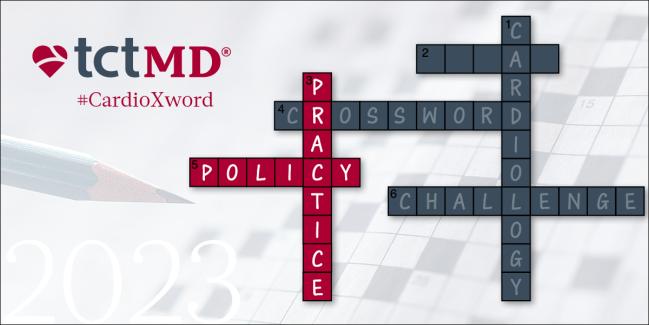Top Policy and Practice News for Cardiologists in 2023
As the COVID-19 pandemic officially ended, cardiologists had more headspace for introspection and growth.

Cardiology, like the world as a whole, had more headspace for introspection and growth in 2023 as the COVID-19 pandemic officially ended, allowing for shifts in practice and public policy.
Perhaps most on the minds of cardiologists is the momentum to create a new, independent medical board. The move comes after years of friction over the American Board of Internal Medicine (ABIM; 6 Down*) mandate that midcareer physicians must pursue Maintenance of Certification (MOC) to show their competency—a process that many cardiologists have argued is time-consuming and expensive. Application for the new board to the American Board of Medical Specialties is imminent, TCTMD reported this month.
Also gaining steam in 2023 have been debates over what constitutes the right credentials for managing patients with heart disease. Highlighting the tensions over scope of practice was the furor kicked off when Glenfield Hospital’s cardiology X (formerly Twitter) account congratulated an advanced nurse practitioner (ANP; 44 Down) for performing a TAVI case as first operator. The resulting firestorm focused on safety concerns as well as worries that physician trainees might be missing out on chances to learn structural heart skills.
TCTMD spoke with Cathleen Biga, MSN, RN, president and CEO of Cardiovascular Management of Illinois and president-elect of the American College of Cardiology (CATHLEEN; 30 Down), who observed that it’s been a year of evolutions in team-based care and scope of practice that are important to “both applaud and watch carefully.”
This year marked the second for in-person meetings in the postpandemic era, with many dropping the option of live remote attendance, which in turn led to more discussion about how to balance work and life commitments against the fear of missing out (FOMO; 5 Down). For years, Twitter has been the place to keep up with live meeting updates, but many cardiologists have soured on the new “X” platform and a few have quit altogether.
But if some are pushing pause on some digital interactions, they may yet be turning to other online tools, including artificial intelligence (AI) and large language models. ChatGPT (19 Across) became one of the most talked-about technologies of the year and left journal editors scrambling to create rules around how to acknowledge AI “authorship” on submitted articles.
On the regulatory front, major US Food and Drug Administration decisions on drugs and devices made headlines. These include the approval of the first pulsed-field ablation catheter, two renal denervation (RDN; 54 Down) systems for treating high blood pressure, the first extravascular ICD (EVICD; 16 Across), the LimFlow (20 Down) device, and colchicine (2 Down), an old drug made new in CAD prevention, among others.
Lastly, two evolving approaches may help with the chronic shortage of hearts for transplantation. Leading the way is research supporting the safety and efficacy of hearts donated after circulatory death (DCD; 52 Down), while much more preliminary steps continue in the realm of genetically modified porcine hearts (PIG; 37 Down).
What Did We Miss?
Our Cardiology Crossword Challenge inevitably missed plenty of important developments this year.
Biga pointed out that the US Centers for Medicare & Medicaid Services physician fee schedule issued in late 2023, set to go into effect January 1, 2024, has elements that will impact the delivery of CV care: community health integration services, social determinants of health risk assessment, caregiver training, and principal illness navigation services. The latter two help overcome some limitations of existing chronic care codes, which have been hard for practices to implement, she explained. “If we can really teach the family members to prevent readmissions and hospitalizations and ED visits,” such caregivers would be a valuable focal point.
The endorsement for social determinants of health, noted Biga, will make it easier for clinicians to do their part in addressing equity.
Also pivotal, from a financial perspective, is the American Medical Association’s ongoing Physician Practice Information Survey. Responses to the survey will help policymakers understand the costs involved in running a medical practice, Biga stressed: if these numbers aren’t accurate, Medicare physician payments could suffer.
“The other thing that I think is critical that we’ve got to watch next year [is] how we do shared services,” said Biga. The goal is to help maximize the skill sets of everyone on the team—physicians, advanced practice nurses, registered nurses, pharmacists, etc—to “get that patient where they need to go . . . and still get paid for that whole embracing of the team.”
And finally, US cardiologists should expect Medicare to continue the trajectory toward quality as a metric that factors into reimbursement, Biga highlighted. Within the agency’s Quality Payment Program (QPP), there’s now not only the Merit-Based Incentive Payment System (MIPS) but also, as of 2023, the MIPS Value Pathways (MPVs) reporting option. In 2024, she predicted the concept of value will become even more important.
As to the stewing controversies over scope of practice and shifting roles in cardiology, she herself has faced pushback over being the first nonphysician to lead the ACC. In her view, this expertise brings a unique perspective.
The reality is “we have a physician workforce shortage [and] a nurse workforce shortage,” so it’s necessary to find solutions, Biga commented. There are changes afoot, such as HR 2583, a bill specifying physicians aren’t the only ones able to prescribe cardiac rehabilitation, which will bring changes in this regard.
Team-based care, to be done right, requires balance, she stressed. It involves making “sure everyone is working at the top of their license and not over their license, making sure people are working in their lane,” said Biga. “What we need within CV care delivery is a mechanism that weaves. . . . Medicine is an art as well as a science. This weaving together of everybody’s skill sets comes out into a beautiful brocade, but only if it’s woven with the strengths of each individual aligned in the right way.”
As cardiology becomes ever more specialized—and subspecialized—every team member offers their own expertise, she added.
*All of our end of year stories for 2023 contain clues to our Cardiology Crossword Challenge.
Caitlin E. Cox is News Editor of TCTMD and Associate Director, Editorial Content at the Cardiovascular Research Foundation. She produces the…
Read Full Bio




Comments